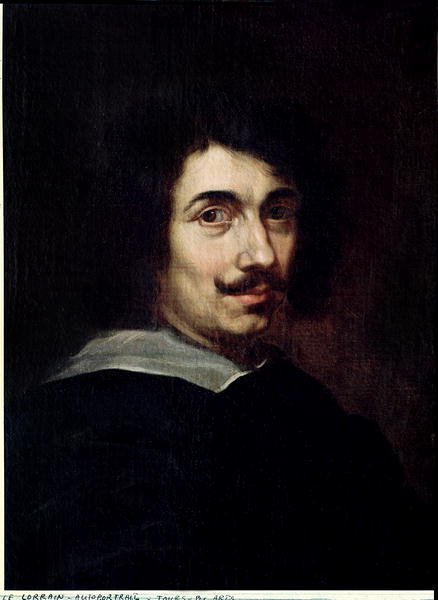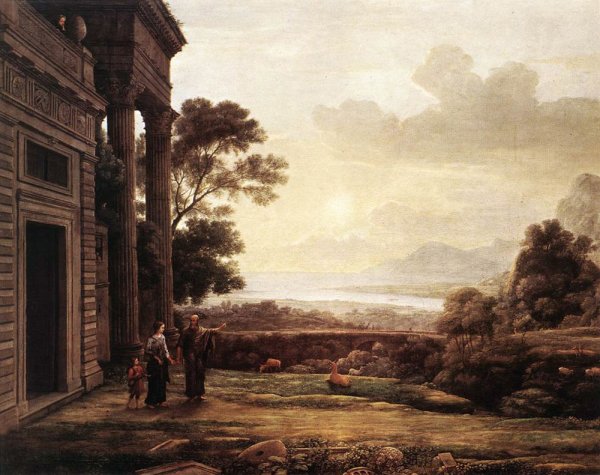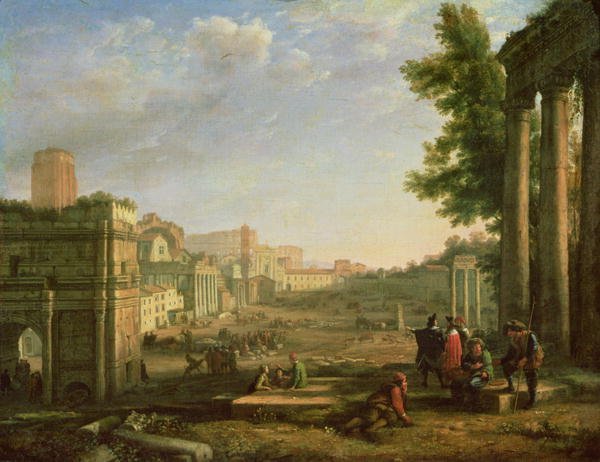Claude Lorrain (Gellee) Biography In Details
Early years

Claude Lorrain (Gellee) was born in 1604 or 1605 into poverty in the town of Chamagne, Vosges in Lorraine - then the Duchy of Lorraine, an independent state until 1766. He was one of five children. His actual name was Claude Gellée, but he is better known by the province in which he was born. Orphaned by age of twelve, he went to live at Freiburg with an elder brother, Jean Gellée, a woodcarver. He afterwards went to Rome to seek a livelihood and then to Naples, where he apprenticed for two years, from 1619 to 1621, under Goffredo (Gottfried) Wals. He returned to Rome in April 1625 and was apprenticed to Augustin Tassi. He got into a fight with Leonaert Bramer.
He apparently was able to tour in Italy, France and Germany, including his native Lorraine, suffering numerous misadventures. Claude Deruet, painter to the duke of Lorraine, kept him as assistant for a year; and at Nancy he painted architectural subjects on the ceiling of the Carmelite church.
Mature works

In 1627 Lorrain returned to Rome. Here, two landscapes made for Cardinal Bentivoglio earned him the patronage of Pope Urban VIII. From about 1637 he rapidly achieved fame as a painter of landscapes and seascapes. He apparently befriended his fellow Frenchman Nicolas Poussin; together they would travel the Roman Campagna, sketching landscapes. Though both have been called landscape painters, in Poussin the landscape is a background to the figures; whereas for Lorrain, despite figures in one corner of the canvas, the true subjects are the land, the sea, and the air. By report, he often engaged other artists to paint the figures for him, including Courtois and Filippo Lauri. He remarked to those purchasing his pictures that he sold them the landscape; the figures were gratis.
In order to avoid repetition of subjects, and also to expose the many spurious copies of his works, he made tinted outline drawings (in six paper books prepared for this purpose) of all those pictures sent to different countries; and on the back of each drawing he wrote the name of the purchaser. These volumes he named the Liber Veritatis (Book of Truth). This valuable work, engraved and published, has always been highly esteemed by students of the art of landscape. Claude, who suffered much from gout, died in Rome on either 21 November or 23 November 1682, leaving his considerable wealth between his only surviving relatives, a nephew and an adopted daughter (possibly his niece). Originally buried in Santissima Trinità al Monte Pincio (commonly known as Trinità al Monte), at top.
Critical assessment and legacy

In Rome, not until the mid-17th century were landscapes deemed fit for serious painting. Northern Europeans, such as the Germans Elsheimer and Brill, had made such views pre-eminent in some of their paintings (as well as Da Vinci in his private drawings or Baldassarre Peruzzi in his decorative frescoes of vedute); but not until Annibale Carracci and his pupil Domenichino do we see landscape become the focus of a canvas by a major Italian artist. Even with the latter two, as with Lorrain, the stated themes of the paintings were mythic or religious. Landscape as a subject was distinctly unclassical and secular. The former quality was not consonant with Renaissance art, which boasted its rivalry with the work of the ancients. The second quality had less public patronage in Counter-Reformation Rome, which prized subjects worthy of "high painting," typically religious or mythic scenes. Pure landscape, like pure still-life or genre painting, reflected an aesthetic viewpoint regarded as lacking in moral seriousness. Rome, the theological and philosophical center of 17th century Italian art, was not quite ready for such a break with tradition.
In this matter of the importance of landscape, Lorrain was prescient. Living in a pre-Romantic era, he did not depict those uninhabited panoramas that were to be esteemed in later centuries, such as with Salvatore Rosa. He painted a pastoral world of fields and valleys not distant from castles and towns. If the ocean horizon is represented, it is from the setting of a busy port. Perhaps to feed the public need for paintings with noble themes, his pictures include demigods, heroes and saints, even though his abundant drawings and sketchbooks prove that he was more interested in scenography.
Lorrain was described as kind to his pupils and hard-working; keenly observant, but an unlettered man until his death. The painter Joachim von Sandrart is an authority for Claude's life (Academia Artis Pictoriae, 1683); Baldinucci, who obtained information from some of Claude's immediate survivors, relates various incidents to a different effect (Notizie dei professoni del disegno).
John Constable described Claude Lorrain as "the most perfect landscape painter the world ever saw", and declared that in Claude's landscape "all is lovely - all amiable - all is amenity and repose; the calm sunshine of the heart". (From Wikipedia)




